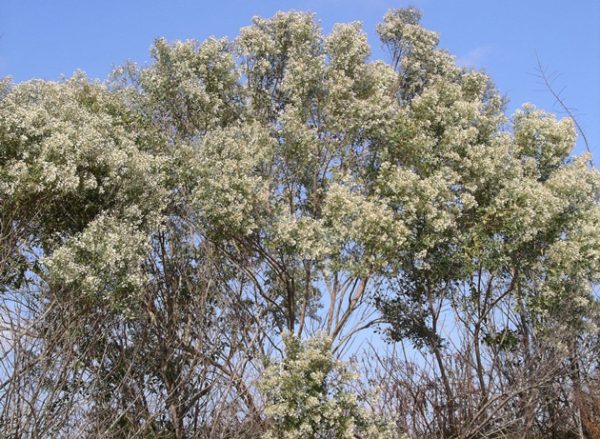Saltbush – native but invasive

During a recent trip to the beach, I realized a number of plants native to the Coastal Plain have found a home in the Piedmont. Yaupon holly, beautyberry, wax myrtle and sweetbay magnolia have become staples in our gardens. Pitcher plants and longleaf pines occur in the natural landscapes of the Uwharries. A botanist friend jokes that species from the Coastal Plain like to “slum it” in our region. These outlying populations speak to our location on the sloppy margins of two distinct ecosystems. They’re also evidence of our ancient history, recalling a time when the ocean lapped against the Uwharries’ eastern flank.
 In more recent times, a species from the beach has expanded its range into the Piedmont. This interloper goes by the names sea myrtle and groundsel tree, but it’s commonly known as saltbush (Baccharis halimifolia) because it tolerates salt spray and brackish water. In its native habitat at the edge of a marsh, it remains a somewhat compact, evergreen shrub. The gray-green leaves are small and coarsely-toothed and somewhat leathery to the touch. Saltbush can be a handsome shrub, especially in the fall when it’s covered with fluffy white seeds.
In more recent times, a species from the beach has expanded its range into the Piedmont. This interloper goes by the names sea myrtle and groundsel tree, but it’s commonly known as saltbush (Baccharis halimifolia) because it tolerates salt spray and brackish water. In its native habitat at the edge of a marsh, it remains a somewhat compact, evergreen shrub. The gray-green leaves are small and coarsely-toothed and somewhat leathery to the touch. Saltbush can be a handsome shrub, especially in the fall when it’s covered with fluffy white seeds.
In the Piedmont, saltbush apparently first took root along the shoulders of our major thoroughfares. Some people speculate the seeds traveled in the grilles of automobiles returning from the coast. Perhaps they felt right at home in the briny gravel, a microhabitat we created by salting our icy roads. Others say saltbush found fertile ground in landscapes we have altered – it thrives in waste places and quickly appears after a clear cut – much like the coyote expanded east of the Mississippi after we cleared tracts for agriculture and extirpated the native red wolf.
Much to my dismay, saltbush also loves to insinuate itself in our early successional habitats, plaguing our efforts to restore Piedmont prairies and longleaf pine savannahs. Once established, it upsets a delicate balance. In our experience, it tolerates fire but doesn’t provide sufficient fuel to stoke a hot burn. Even if we manage to knock it back with a top-kill, it sprouts again from the roots. Colonies can grow large and dense, shading out more desirable grasses and forbs and making it even harder to carry a fire.
The N.C. Native Plant Society and N.C. Natural Heritage Program consider saltbush an invasive species, a dubious distinction usually reserved for exotic plants from faraway nations, not a native of our very own state. Invasive plants typically run rampant here because they lack a suite of predators, diseases and growing conditions that kept them in check back home. At first glance, a plant expanding its range by a couple hundred miles might not seem quite as dramatic, but its insidious creep is arguably even more disturbing.
If a species now thrives in a place where it didn’t occur for millennia, it seems to me there has been a cataclysmic shift. While the theories about car grilles and altered landscapes seem plausible, they don’t take into account that people cleared the land and traveled back and forth across the state long before this species arrived in our region. Conditions today must be different somehow. Of course, the specter of climate change comes to mind. In an era of global warming, saltbush might be one of many species we will notice moving inland. I’m tempted to abandon our efforts to control it in our early successional habitats. Perhaps the lines between the Piedmont and the Coastal Plain are blurring. If temperatures continue to rise, there might come a time when the ocean once again finds its way to the base of our hills. Saltbush will be here, waiting.